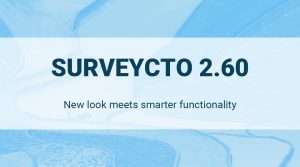Unlock the potential of conjoint analysis for better decision-making
When conducting data collection for social impact, the goal is to not only collect information, but to be able to understand the nuanced preferences of diverse communities. This is where conjoint analysis can be a powerful tool.
Originally developed for market research to decode consumer preferences, conjoint analysis is a research technique that lets you determine how people value different attributes of a product, program, or service. It has proven to be extremely useful in evaluating the impact of various programs and services provided by NGOs, educational bodies, health organizations, and other social impact organizations. Through conjoint analysis, organizations can dissect how different components of a program are valued by their beneficiaries, leading to more effective and tailored interventions.
Whether you’re looking to refine data-driven decisions or simply expand your methodological toolkit, understanding how to utilize conjoint analysis will elevate your research and help you achieve more meaningful impact in your field. This guide aims to help you do this by giving you a better understanding of how to use conjoint analysis in real-world applications.
Real-world social impact use cases for conjoint analysis

Conjoint analysis can significantly enhance program outcomes by helping organizations better understand human preferences or nuanced differences. To illustrate how conjoint analysis can be effectively applied to optimize initiatives across various fields such as humanitarian aid, health services, agriculture, and community health programs, here are several real-world applications for conjoint analysis.
Impact evaluations
Conjoint analysis is invaluable within the social impact sector, aiding organizations in understanding how different service attributes affect community decisions and engagements. By presenting community members with various configurations of service options, researchers can assess the impact of specific aspects on preferences and willingness to commit or participate. This method allows nonprofits, NGOs, and social enterprises to tailor their programs, interventions, and messaging to better meet the needs and preferences of their target communities. Whether it’s determining the most effective educational programs, health interventions, or community development projects, conjoint analysis provides deep insights that help these organizations optimize their offerings and enhance their impact on society.
Humanitarian aid
Imagine an international NGO that provides food aid in areas affected by humanitarian crises and seeks to optimize its delivery by understanding beneficiary preferences. They utilize conjoint analysis to evaluate which aspects of their food aid program—such as food quality, delivery frequency, delivery method, community involvement, and nutritional information—are most crucial to recipients. The data collection instrument includes two sets of program profiles for recipients to choose between.
In the first choice set, recipients decide between a basic food quality program with monthly central distribution and no community involvement or nutritional information, versus a high-quality food program with weekly home deliveries, active community involvement, and provided nutritional information. The second set asks recipients to choose between a program offering basic food quality with beneficial weekly home deliveries, active community involvement but no nutritional information, and another providing high-quality food with less frequent central distribution, no community involvement but includes nutritional information. These insights are invaluable for the NGO to tailor their food aid programs effectively, ensuring they meet the real needs of the recipients while optimizing resource allocation.
Health services
In the context of refugee camps, where healthcare needs can vary dramatically, conjoint analysis can contribute towards the customization of health and educational programs. By assessing preferences for various medical treatments, psychological support, and educational content through surveys, programs can be specifically adapted to enhance participation and outcome. This targeted approach ensures that services are not only more accessible but also more effective, aligning closely with the specific needs and preferences of displaced populations.
Agriculture
Consider an agricultural research institution looking to introduce a new seed variety. Conjoint analysis can be used to determine which attributes—such as yield potential, drought resistance, or cost—are most valued by local farmers. This insight allows researchers to focus on developing seed varieties that address the most pressing needs of the farmers, thereby increasing adoption rates and improving agricultural productivity.
Community health programs
When planning a new community health initiative, conjoint analysis helps pinpoint which program attributes are most needed by the community, such as the frequency of health worker visits, the range of services provided, or the proximity of healthcare facilities. By understanding and prioritizing these attributes, health programs can be designed to meet the actual needs of the community, increasing engagement with the program and improving health outcomes.
Monitoring and evaluation (M&E)
In monitoring and evaluation, conjoint analysis serves as a strategic tool to assess the effectiveness of various program interventions. By engaging participants in evaluating different aspects of a program—from its delivery methods to the scope of its services—organizations can better understand how these factors influence overall satisfaction and effectiveness. This approach not only helps identify the most impactful components of a program but also provides a more granular understanding of participants’ experiences with the program or intervention. This helps organization make more precise adjustments to enhance future program delivery. Conjoint analysis thus supports ongoing improvement processes, ensuring that interventions remain responsive to participant needs and expectations while achieving desired outcomes.
Empower yourself to collect more robust data with conjoint analysis

By deeply understanding how different attributes influence decisions, conjoint analysis enables the design of services and products that truly resonate with target populations. Whether it’s enhancing the effectiveness of humanitarian aid, optimizing health services, or increasing agricultural productivity, conjoint analysis provides the insights needed to make informed and impactful decisions.
SurveyCTO supports this powerful research technique through its conjoint analysis plug-in, part of our field plug-in catalog. This plug-in simplifies the setup and execution of conjoint studies, making it accessible even to those with a moderate level of form design knowledge.
With SurveyCTO, users can easily configure and deploy their conjoint analysis surveys, ensuring they collect high-quality data that’s ready for in-depth analysis. Our 24/7 customer support is also always standing by to help, should any questions arise.
By integrating conjoint analysis into your data collection efforts with SurveyCTO, you elevate the standard of your research and extend its reach, ensuring that every project or program you undertake is as effective and beneficial as possible.
Want to learn more? Dive into our support center to explore our detailed conjoint analysis guide and workflow, and watch our conjoint analysis webinar for step-by-step instructions on using this technique. Want to try conjoint analysis out for yourself? Start a free trial to see how SurveyCTO can enhance your work with conjoint analysis.




